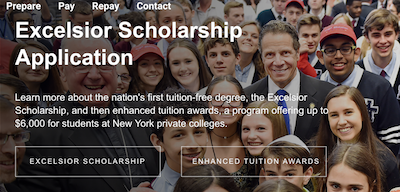Sean Tvelia
On June 7 applications for New York's new Excelsior Scholarship opened up. Despite how the program has been billed, this is not "free college" and the program may not live up to all the hype. I have serious concerns about whether and to what degree Excelsior might benefit our students here at SCCC. First, the program is overseen by the state's Higher Education Services Corporation (HESC), and you can visit their Excelsior frequently asked questions page, which covers many issues of concern. How many New Yorkers might benefit? The HESC website notes that the Excelsior Scholarship aims to provide "the nation's first tuition-free degree" for public colleges or up to $6,000 for New York's private colleges for residents with an adjusted household income of less than $100,000 per year in 2017–18, $110,000 in 2018–19 and $125,000 in 2019–20. This year, it is estimated that about 940,000 families in the state meet the financial requirement of less than $100,000 per year and have college-age students. It's unknown how many of the estimated eligible students are actually community college students, but New York State United Teachers (as well as the NYS Assembly) are indicating that estimates for who qualifies should be closer to about 32,000 due to the academic requirements. Thus I think The New York Times has correctly noted that Excelsior will not benefit the majority of the 600,000 SUNY students enrolled in credit-bearing courses and programs. How many SCCC students might benefit? And in community colleges like SCCC, things might look even worse. Relying on some of the SCCC's data collected as part of our Achieving the Dream initiative, here's why:
From scholarship to loan Here's how the program works: If the student qualifies financially and is awarded an Excelsior Scholarship, SCCC defers receipt of tuition from that student. If the student successfully completes their first year—with the required number of credits and meeting their curriculum GPA requirements—the state then pays SCCC for that student's tuition. However, if the student fails to meet the educational or time-to-degree requirements, the scholarship reverts to a loan. If the student successfully completes their first year but not their second year, the student then owes the state for that one year of tuition. The residency requirement The other complication is the residency requirement attached to the Excelsior Scholarship. If the student successfully completes both years and graduates from SCCC within the two-year timeframe, they are required to reside in and be employed within New York for two years (which will probably be tracked by the Department of Labor). If the student only successfully completed and received Excelsior for one year, then they are obligated to reside in and be employed within New York for one year. This shouldn't prove too problematic, as approximately 85 percent of SUNY graduates stay in the state anyway. However, we are not yet sure about the employment piece of the residency requirement. For example, say a geology major leaves SCCC with an Excelsior and continues at Stony Brook with an Excelsior and does everything they're supposed to do. However, upon graduation, the only jobs they can find in geology are out of state. Now, they might find a local retail or service position to satisfy the Excelsior requirement but that puts them behind two years in their geology career in terms of years of work experience compared with their peers. Hope for the best I've heard suggestions that perhaps the Excelsior Scholarship might actually boost community college enrollments because some of the four-year SUNY colleges are actually at capacity, their dorms are filled, etc., and since students must get accepted to an institution before they can apply for Excelsior—and community colleges are more open in our enrollment policies—maybe, just maybe, more students will enroll in community colleges like ours. That remains to be seen. We will need to keep a close eye on the impact of the Excelsior Scholarship at SCCC and hope that does move our state ever upward in making higher education more accessible and affordable. |
